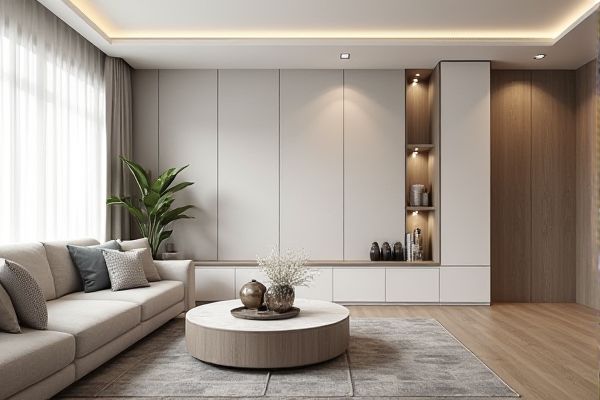
PVC paneling offers a lightweight, cost-effective, and water-resistant solution ideal for areas prone to moisture, while ceramic paneling provides superior durability, heat resistance, and a more elegant, long-lasting finish suitable for high-traffic or decorative spaces. Explore the rest of the article to discover which option best fits your project's needs and preferences.
Table of Comparison
| Feature | PVC Paneling | Ceramic Paneling |
|---|---|---|
| Material Composition | Polyvinyl Chloride (Synthetic Plastic) | Porcelain or Clay-based Ceramic |
| Durability | Moderate; Resistant to Moisture & Mold | High; Extremely Hard & Scratch Resistant |
| Installation | Easy; Lightweight and Click-fit Panels | Complex; Requires Skilled Labor and Adhesives |
| Maintenance | Low; Wipe Clean with Mild Detergents | Low; Stain and Heat Resistant, Easy Cleaning |
| Water Resistance | Excellent; Ideal for Bathrooms & Kitchens | Excellent; Impervious to Water |
| Cost | Low to Moderate | Moderate to High |
| Design Variety | Wide Range of Colors & Patterns | Various Styles, Often Limited by Tile Size |
| Environmental Impact | Non-biodegradable; Recycling Limited | Natural Materials; More Environmentally Friendly |
| Typical Applications | Residential Walls, Ceilings, Wet Areas | Bathrooms, Kitchens, Facades, Flooring |
Introduction to Paneling Materials
PVC paneling offers lightweight, water-resistant properties ideal for moisture-prone areas, providing easy installation and low maintenance. Ceramic paneling delivers superior durability, heat resistance, and a premium aesthetic, commonly used in high-traffic or heat-exposed environments. Both materials vary significantly in cost, longevity, and texture, influencing suitability for residential or commercial applications.
Overview of PVC Paneling
PVC paneling offers a lightweight, water-resistant solution for interior wall finishes, ideal for moisture-prone areas like bathrooms and kitchens. Made from polyvinyl chloride, these panels are easy to install, low-maintenance, and provide a cost-effective alternative to traditional ceramic tiles. PVC paneling also delivers good insulation properties and is available in various colors and textures to match diverse interior designs.
Overview of Ceramic Paneling
Ceramic paneling offers exceptional durability, water resistance, and ease of maintenance, making it ideal for both indoor and outdoor applications. Its high temperature tolerance and resistance to stains and scratches ensure long-lasting aesthetic appeal compared to PVC paneling. If you're seeking a premium, eco-friendly solution with superior structural integrity, ceramic paneling enhances your space with a modern, polished finish.
Installation Process: PVC vs Ceramic
PVC paneling offers a straightforward installation process, as panels are lightweight and can be easily cut and snapped into place using basic tools, making it suitable for DIY projects and quick wall or ceiling upgrades. Ceramic paneling installation is more complex, requiring skilled labor to handle heavy tiles, apply adhesive, and grout between tiles, which demands precise measurements and longer curing times for durability. Your choice between PVC and ceramic paneling will impact installation time, cost, and required expertise, with PVC being faster and simpler while ceramic provides a more permanent and sturdy finish.
Durability and Lifespan Comparison
PVC paneling offers excellent durability with resistance to moisture, mold, and impact, making it ideal for humid environments and high-traffic areas, and typically lasts 10-20 years with proper maintenance. Ceramic paneling provides superior hardness and scratch resistance, with a lifespan often exceeding 25 years due to its ability to withstand temperature fluctuations and heavy wear. While ceramic panels excel in durability, PVC panels offer flexible installation and water resistance, influencing material choice based on specific application needs.
Maintenance and Cleaning Requirements
PVC paneling offers low maintenance with its water-resistant and stain-resistant surface, requiring only simple wiping with a mild detergent and a damp cloth to keep it clean and free from mold or mildew. Ceramic paneling demands more careful cleaning routines to avoid scratching and the use of non-abrasive cleaners to maintain its glazed finish, although it resists stains and water damage effectively. Both materials provide durable options, but PVC paneling is more convenient for quick and frequent cleaning in high-moisture environments.
Aesthetic Versatility and Design Options
PVC paneling offers extensive aesthetic versatility with a wide range of colors, patterns, and textures that easily mimic wood, stone, or tile, making it ideal for customizable interior designs. Ceramic paneling provides a more traditional and durable choice with varied glazes and finishes that add elegance and a premium feel, especially in wet areas like bathrooms and kitchens. Your choice between PVC and ceramic paneling should consider design flexibility alongside the desired ambiance and maintenance requirements of your space.
Cost Analysis: PVC vs Ceramic
PVC paneling offers a cost-effective solution with lower initial investment, averaging $2 to $5 per square foot, making it ideal for budget-conscious projects. Ceramic paneling, priced between $7 and $15 per square foot, incurs higher material and installation costs due to its durability and labor-intensive application. Maintenance expenses favor PVC, as it is easier to clean and repair, whereas ceramic requires periodic grout replacement and careful handling to prevent cracks.
Environmental Impact and Sustainability
PVC paneling generates significant environmental concerns due to its non-biodegradable nature and reliance on fossil fuels for production, contributing to pollution and landfill waste. Ceramic paneling offers enhanced sustainability, as it is made from natural clay and minerals, is recyclable, and has a longer lifespan with low maintenance requirements. Life cycle assessments consistently show ceramic panels have lower carbon footprints and reduced environmental impact compared to plastic-based PVC alternatives.
Best Applications for Each Paneling Type
PVC paneling excels in moisture-prone environments such as bathrooms, kitchens, and basements due to its water resistance and ease of maintenance. Ceramic paneling is best suited for high-traffic areas like commercial spaces and exterior facades because of its durability, heat resistance, and aesthetic versatility. Choosing between these materials depends on factors like exposure to moisture, required durability, and design preference.
 homyna.com
homyna.com